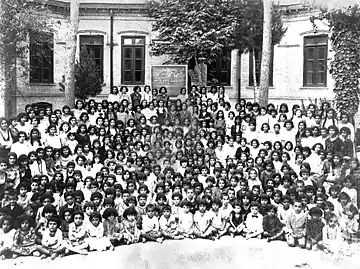
Since its inception the Baháʼí Faith has had involvement in socioeconomic development beginning by giving greater freedom to women,[2] promulgating the promotion of female education as a priority concern,[3] and that involvement was given practical expression by creating schools, agricultural coops, and clinics.[2]
Current development activities worldwide are related to areas such as education, health, agriculture, arts and media, the local economy and the advancement of women. By 2017 there were an estimated 40,000 small-scale local projects, 1,400 sustained projects with administrative structure (e.g. schools, radio stations, gardens), and 135 Baháʼí-inspired development organizations (e.g. FUNDAEC, New Era High School).[4]
Historical development
The accelerated growth of the worldwide community in the 1960s-1980s expanded it with a large number of poor, illiterate villagers and tribal peoples in India, Africa and South America, which meant an enormous challenge for the social and economic development of communities. According to the Baháʼí teachings, development should increase people's self-reliance, communal solidarity, giving access to knowledge, and, where possible, removing sources of injustice. Spiritual, moral and material development should be linked together.[5] These priorities are envisioned as crucial to the development of world peace.
The religion entered a new phase of activity when a message of the Universal House of Justice dated 20 October 1983 was released.[6][7] The Office of Social and Economic Development was established[8] and Baháʼís were urged to seek out ways, compatible with the Baháʼí teachings, in which they could become involved in the social and economic development of the communities in which they lived. Worldwide in 1979 there were 129 officially recognized Baháʼí socioeconomic development projects. By 1987, the number of officially recognized development projects had increased to 1482.[6]
In time with the release of the Universal House of Justice's release of its statement The Promise of World Peace, it also sent a letter of all national assemblies to specify goals for the community for the International Year of Peace.[9] These goals included sponsoring activities about the theme of peace which is a priority of the religion: to engage the attention of people to relevant topics related to peace (often related matters of justice and development) and the unity of humanity.
Current situation
The Baháʼís around the world are currently being encouraged to focus on capacity building through activities such as spiritual education of children, a youth empowerment program, study circles, and devotional gatherings.[10] For most of these activities, material developed by the Ruhi Institute is used.[11] Initiatives of social action include activities in areas like health, sanitation, education, gender equality, arts and media, agriculture, and the environment.[4] Educational projects include schools, which range from village tutorial schools to large secondary schools, and some universities.[5]
Statistics
In November 1986, the Baha'i department of statistics released the following summary of projects accomplished:[12]
| Programs | World | Africa | Americas | Asia | Australasia | Europe |
|---|---|---|---|---|---|---|
| Education (tutorial/academic/other) | 732 | 169 | 115 | 427 | 13 | 8 |
| Health and social services | 78 | 28 | 14 | 25 | 2 | 9 |
| Radio stations | 5 | 0 | 5 | 0 | 0 | 0 |
| Agriculture and forestry | 74 | 35 | 13 | 20 | 5 | 1 |
| Community development | 358 | 60 | 266 | 12 | 7 | 13 |
| Total | 1247 | 292 | 413 | 484 | 27 | 31 |
In April 2018, the Baháʼí Office of Social and Economic Development released the following conservative estimates, based on provided by national Baháʼí institutions.[4]
| Baháʼí Development Activities Worldwide | 1996 | 2001 | 2006 | 2011 | 2017 |
|---|---|---|---|---|---|
| Activities of fixed duration | >1,300 | >2,400 | >7,000 | >18,000 | >40,000 |
| Sustained projects | >250 | >500 | >650 | >1,100 | >1,400 |
| Baháʼí inspired organizations | 39 | 62 | 83 | 118 | 135 |
Some particular examples
- The Baháʼí International Community, an international non-governmental organization, maintains a presence devoted to supporting and coordinating socioeconomic development activities at the United Nations as well as presenting papers and reports of activities of the religion to UN agencies on themes of development and peace.[13]
- Related to the International Year of Peace in 1986, public conferences and seminars were organized in several countries.[14][15][16][17]
- Baháʼís and interested parties have participated in an annual conference since 1999 sponsored by the Rabbani Charitable Trust in Orlando, Florida .[18] Mildred Mottahedeh gave nearly all her wealth away by establishing charities such as the Mottahedeh Development Services. The Baháʼí Chair for World Peace is located at the Center for International Development and Conflict Management under the auspices of the College of Behavioral and Social Sciences at the University of Maryland.[19]
List of Baháʼí-inspired organizations
Some larger scale examples are:
- FUNDAEC, Colombia
- New Era High School, India
- Barli Development Institute for Rural Women, India
- Banani International Secondary School, Zambia
- Nur University, Bolivia
- School of the Nations, Brazil
- School of the Nations, Macau
- Townshend International School, Czech Republic
- Tahirih Justice Center, United States
- Dawn Breakers International Film Festival, United States
See also
References
- ↑ History of Baháʼí Educational Efforts in Iran (archived).
- 1 2 Momen, Moojan. "History of the Baha'i Faith in Iran". draft "A Short Encyclopedia of the Baha'i Faith". Bahai-library.com. Retrieved 2009-10-16.
- ↑ Kingdon, Geeta Gandhi (1997). "Education of women and socioeconomic development". Baháʼí Studies Review. 7 (1).
- 1 2 3 Baháʼí Office of Social and Economic Development (2018). For the Betterment of the World: The Worldwide Baháʼí Community's Approach to Social and Economic Development.
- 1 2 Momen, Moojan (2007). "The Baháʼí Faith". New Lion Handbook: The World's Religions. Oxford: Lion Hudson Plc. p. 464. ISBN 978-0-7459-5266-6.
- 1 2 Momen, Moojan; Smith, Peter (1989). "The Baha'i Faith 1957–1988: A Survey of Contemporary Developments". Religion. 19: 63–91. doi:10.1016/0048-721X(89)90077-8.
- ↑ Universal House of Justice (20 October 1983). To the Baháʼís of the World.
- ↑ Smith, Peter (2008). An Introduction to the Baha'i Faith. Cambridge University Press. ISBN 978-0-521-86251-6.
- ↑ "Make plans now for 'Peace Year 1986'". Baháʼí News. No. 648. March 1985. p. 1. ISSN 0195-9212.
- ↑ Gervais, Marie (2008). "Bahaʼi Faith and Peace Education" (PDF). Encyclopedia of Peace Education. New York: Teachers College, Columbia University. Retrieved 3 May 2018.
- ↑ Rosemary Blosson; Sylvia B Kaye (March 14, 2012). "Learning by Doing: Preparation of Baha'i Nonformal Tutors". New Directions for Adult and Continuing Education. 2012 (133): 45–57. doi:10.1002/ace.20006.
- ↑ "Baha'i Social and Economic Development Programs". Baháʼí News. No. 668. November 1986. p. 13. ISSN 0195-9212.
- ↑
- Preparation for Life in Peace: The Contribution of Women, by the Baháʼí International Community, as the written version of an oral statement to the European Regional Seminar for the International Year of Peace, 6 May 1985, Vienna, Austria
- Peace and Development, by the Baháʼí International Community, as a Statement to the United Nations International Year of Peace Seminar for the Asia and Pacific and Western Asia Regions, 20 May 1985, Bangkok, Thailand
- Preparation for Life in Peace: The Role of Youth, by the Baháʼí International Community as a Statement to the International Year of Peace Seminar for the Asia, Pacific and Western Asia Regions, 20 May 1985
- Statement on the Year of Peace, by the Baháʼí International Community, as a Statement to the Fifth session of the South Pacific Commission (SPC) Committee of Representatives of Governments and Administrations (CARGA), Noumea, New Caledonia, 26–30 May 1986
- ↑ "Germany proclaims message of peace". Baháʼí News. No. 662. May 1986. p. 12. ISSN 0195-9212.
- ↑ "India hosts 'World Peace Conference'". Baháʼí News. No. 662. July 1986. p. 12. ISSN 0195-9212.
- ↑ "Around the World; Pakistan". Baháʼí News. No. 662. October 1986. p. 14. ISSN 0195-9212.
- ↑ "Association's 11th annual Conference". Baháʼí News. No. 662. December 1986. p. 8. ISSN 0195-9212.
- ↑ "Social and Economic Development Conference History". Rabbani Charitable Trust. Retrieved 2012-11-04.
- ↑ "The Baha'i Chair for World Peace". The Baha'i Chair for World Peace. 2015. Retrieved 2015-06-01.
Further reading
- Arbab, Farzam (2000). "Promoting a Discourse on Science, Religion, and Development". In Harper, Sharon (ed.). The Lab, the Temple, and the Market. Ottawa, ON, Canada: International Development Research Centre. ISBN 0889369208.
- Baháʼí Office of Social and Economic Development (2018). For the Betterment of the World: The Worldwide Baháʼí Community's Approach to Social and Economic Development.
External links
- Bahai.org: Social and Economic Development
- A Widening Embrace (chapter 3; 2018 documentary film on bahai.org)
- Institute for Studies in Global Prosperity (ISGP)
- Baha'i-Inspired Charitable Agencies and Social and Economic Development Organizations
- Photographs of Baháʼís alongside others, contributing to the betterment of society
